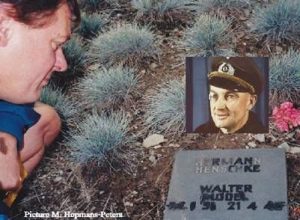Drabik, Alexander Albert, born on 28-02-1910 in Holland, Ohio,  the son of John Drabik and Frances (born Lewandowski) Drabik, Polish immigrants from Szymborze, Germany, now Poland. They raised thirteen children on a farm near Holland and Toledo, Ohio. Alex, youngest son of 14 children, attended Dorr Street School.
the son of John Drabik and Frances (born Lewandowski) Drabik, Polish immigrants from Szymborze, Germany, now Poland. They raised thirteen children on a farm near Holland and Toledo, Ohio. Alex, youngest son of 14 children, attended Dorr Street School.  Alexander enlisted in the United States Army
Alexander enlisted in the United States Army  in October 1942. Prior to his enlistment, he worked as a butcher in Holland, Ohio. Early in his military career, he distinguished himself by rescuing 120 recruits who had become lost in the California desert. Drabik was seriously wounded during the Battle of the Bulge.
in October 1942. Prior to his enlistment, he worked as a butcher in Holland, Ohio. Early in his military career, he distinguished himself by rescuing 120 recruits who had become lost in the California desert. Drabik was seriously wounded during the Battle of the Bulge. 

Squad leader Drabik, part of Able Company 27th Armored Infantry Battalion Combat Command B nickname “Empire”,  9th Armored Divison, nickname the “Phantom Division”
9th Armored Divison, nickname the “Phantom Division”  recieved orders from Company commander Lieutenant Karl Heinrich Timmermann
recieved orders from Company commander Lieutenant Karl Heinrich Timmermann

 to assault the Ludendorff Bridge near Remagen
to assault the Ludendorff Bridge near Remagen  on 07-03-1945, in an effort to seize and holt it. The casualties of the 9th Armored during their European campaign are total battle casualities: 3,845, killed in action: 570, wounded in action: 2,280, missing in action: 87, and prisoner of war 908.
on 07-03-1945, in an effort to seize and holt it. The casualties of the 9th Armored during their European campaign are total battle casualities: 3,845, killed in action: 570, wounded in action: 2,280, missing in action: 87, and prisoner of war 908.
Early in his military career, he distinguished himself by rescuing 120 recruits who had become lost in the California desert. Drabik was seriously wounded during the Battle of the Bulge. Squad leader Drabik, received orders from Company commander, Lieutenant. Karl H. Timmermann to assault the Ludendorff Bridge near Remagen on 07-03-1945, in an effort to seize and hold it.
Under heavy machine-gun fire, Drabik dashed across the bridge while Germans tried desperately to detonate it. He lost his helmet on the way. Drabik was the first American soldier to reach the east side of the bridge. For his heroism, Drabik was awarded the Distinguished Service Cross. ![]() U.S. Representative Marcy Carolyn Kaptur (D-OH)
U.S. Representative Marcy Carolyn Kaptur (D-OH)  has repeatedly sponsored legislation to award him the Medal of Honor.
has repeatedly sponsored legislation to award him the Medal of Honor. 
Karl Timmermann landed with the 7th Infantry Division, nickname “Hourglass Division”  under command of Major General David Goodwin Barr,
under command of Major General David Goodwin Barr, 
 at Inchon, South Korea, in September 1950. He fought with his unit for several months before seeking medical treatment for ongoing abdominal pain. He was diagnosed with testicular cancer and sent back to the U.S. to Fitzsimons Hospital near Denver, Colorado, for treatment. Timmermann underwent surgery to remove the tumor, but treatment was unsuccessful. Karl died on 21-10-1951, at age 29. He was given a full military burial at Fort Logan National Cemetery in Colorado. A Denver reporter wrote that “the cancer called war had failed to take his life in two tries”. His wife LaVera recalled, “He detested cancer because of the fact that it was killing him and depriving him of a soldierly duty … He made me promise to polish up his silver stripe (bar), his buttons and his medals for the burial. He wanted every battle ribbon in proper place on his chest. He wanted to be as soldierly as possible.”
at Inchon, South Korea, in September 1950. He fought with his unit for several months before seeking medical treatment for ongoing abdominal pain. He was diagnosed with testicular cancer and sent back to the U.S. to Fitzsimons Hospital near Denver, Colorado, for treatment. Timmermann underwent surgery to remove the tumor, but treatment was unsuccessful. Karl died on 21-10-1951, at age 29. He was given a full military burial at Fort Logan National Cemetery in Colorado. A Denver reporter wrote that “the cancer called war had failed to take his life in two tries”. His wife LaVera recalled, “He detested cancer because of the fact that it was killing him and depriving him of a soldierly duty … He made me promise to polish up his silver stripe (bar), his buttons and his medals for the burial. He wanted every battle ribbon in proper place on his chest. He wanted to be as soldierly as possible.”
Drabik was the first American soldier of the 9th Army  under General William Simpson
under General William Simpson

 to cross the Rhine River into Germany. Under heavy machine-gun fire, Drabik dashed across the Erich Ludendorff
to cross the Rhine River into Germany. Under heavy machine-gun fire, Drabik dashed across the Erich Ludendorff



 bridge near Remagen on 07-03-1945, while Germans tried desperately to detonate it. Drabik later said: We ran down the middle of the bridge, shouting as we went. I didn’t stop because I knew that if I kept moving they couldn’t hit me. My men were in squad column and not one of them was hit. We took cover in some bomb craters. Then we just sat and waited for others to come. That’s the way it was.
bridge near Remagen on 07-03-1945, while Germans tried desperately to detonate it. Drabik later said: We ran down the middle of the bridge, shouting as we went. I didn’t stop because I knew that if I kept moving they couldn’t hit me. My men were in squad column and not one of them was hit. We took cover in some bomb craters. Then we just sat and waited for others to come. That’s the way it was.
For his heroism, Drabik was awarded the Distinguished Service Cross ![]() . U.S. Representative Marcy Kaptur has repeatedly sponsored legislation to award him the Medal of Honor.
. U.S. Representative Marcy Kaptur has repeatedly sponsored legislation to award him the Medal of Honor.
The German General Walter Model 
 committed suicide close by, soon after the lost of this bridge and the last commander of the bridge, Major der Wehrmacht, Johannes “Hans” Scheller
committed suicide close by, soon after the lost of this bridge and the last commander of the bridge, Major der Wehrmacht, Johannes “Hans” Scheller

 was executed for leaving the bridge intact, age 22, on 14-03-1945, by a flying court near Birnbach. Drabik later said, we ran down the middle of the bridge, shouting as we went.
was executed for leaving the bridge intact, age 22, on 14-03-1945, by a flying court near Birnbach. Drabik later said, we ran down the middle of the bridge, shouting as we went.


 I didn’t stop because I knew that if I kept moving they couldn’t hit me. My men were in squad column and not one of them was hit. We took cover in some bomb craters. Then we just sat and waited for others to come.
I didn’t stop because I knew that if I kept moving they couldn’t hit me. My men were in squad column and not one of them was hit. We took cover in some bomb craters. Then we just sat and waited for others to come.

 That’s the way it was. Drabik was the son of Mr. and Mrs. John D. Drabik, Polish immigrants who raised thirteen children on a farm near Holland and Toledo, Ohio.
That’s the way it was. Drabik was the son of Mr. and Mrs. John D. Drabik, Polish immigrants who raised thirteen children on a farm near Holland and Toledo, Ohio.  Major General John W. Leonard, Sgt. Alexander A. Drabik and his parents in Toledo Zoo on 18-08-1945. Prior to his enlistment, he worked as a butcher in Holland, Ohio. Early in his military career, he distinguished himself by rescuing 120 recruits who had become lost on the California desert. Drabik was seriously wounded
Major General John W. Leonard, Sgt. Alexander A. Drabik and his parents in Toledo Zoo on 18-08-1945. Prior to his enlistment, he worked as a butcher in Holland, Ohio. Early in his military career, he distinguished himself by rescuing 120 recruits who had become lost on the California desert. Drabik was seriously wounded  with a parade.
with a parade. 
Death and burial ground of Drabik, Alexander Albert.



 General John Leonard died in 1974 and Alexander Drabik was killed, at the old age of 83, in an auto accident in Columbia, Missouri, on 28-09-1993, en route to a reunion of his unit. Drabik is buried with his wife Margarit, who died age 79 in the same accident, on the Resurrection Cemetery in Toledo, Ohio.
General John Leonard died in 1974 and Alexander Drabik was killed, at the old age of 83, in an auto accident in Columbia, Missouri, on 28-09-1993, en route to a reunion of his unit. Drabik is buried with his wife Margarit, who died age 79 in the same accident, on the Resurrection Cemetery in Toledo, Ohio.
Message(s), tips or interesting graves for the webmaster: robhopmans@outlook.com






















Leave a Reply